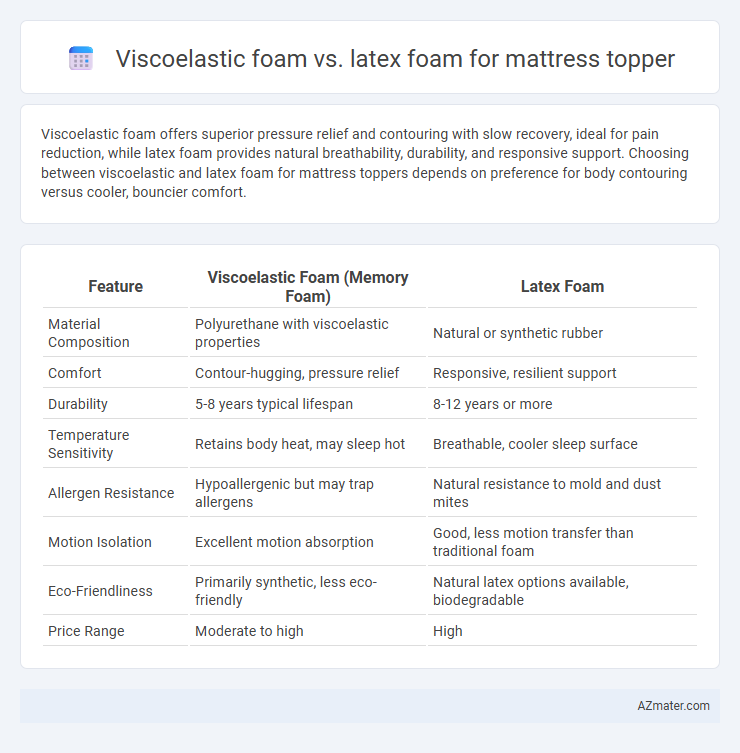Viscoelastic foam offers superior pressure relief and contouring with slow recovery, ideal for pain reduction, while latex foam provides natural breathability, durability, and responsive support. Choosing between viscoelastic and latex foam for mattress toppers depends on preference for body contouring versus cooler, bouncier comfort.
Table of Comparison
| Feature | Viscoelastic Foam (Memory Foam) | Latex Foam |
|---|---|---|
| Material Composition | Polyurethane with viscoelastic properties | Natural or synthetic rubber |
| Comfort | Contour-hugging, pressure relief | Responsive, resilient support |
| Durability | 5-8 years typical lifespan | 8-12 years or more |
| Temperature Sensitivity | Retains body heat, may sleep hot | Breathable, cooler sleep surface |
| Allergen Resistance | Hypoallergenic but may trap allergens | Natural resistance to mold and dust mites |
| Motion Isolation | Excellent motion absorption | Good, less motion transfer than traditional foam |
| Eco-Friendliness | Primarily synthetic, less eco-friendly | Natural latex options available, biodegradable |
| Price Range | Moderate to high | High |
Introduction to Mattress Topper Materials
Viscoelastic foam, also known as memory foam, is a popular mattress topper material renowned for its pressure-relieving properties and contouring ability, which enhances spinal alignment. Latex foam, derived from natural or synthetic sources, offers excellent responsiveness and durability, with natural latex providing resistance to dust mites and allergens. Choosing between viscoelastic and latex foam depends on preferences for softness, breathability, and hypoallergenic characteristics, making each suitable for different sleep needs.
What is Viscoelastic (Memory) Foam?
Viscoelastic foam, commonly known as memory foam, is a polyurethane material infused with viscoelastic chemicals that provide slow response to pressure and body heat, allowing it to conform closely to the sleeper's shape for personalized support and pressure relief. Unlike latex foam, which is naturally buoyant and resilient, memory foam offers superior contouring properties that reduce motion transfer and enhance spinal alignment. This makes viscoelastic foam ideal for mattress toppers aimed at improving comfort by evenly distributing body weight and minimizing pressure points.
What is Latex Foam?
Latex foam is a natural or synthetic material derived from rubber tree sap, known for its durability, breathability, and resilience in mattress toppers. Compared to viscoelastic foam, or memory foam, latex foam provides more responsive support and better airflow, reducing heat retention during sleep. Its hypoallergenic and antimicrobial properties make latex foam an excellent choice for those seeking a cooler, cleaner, and longer-lasting mattress topper option.
Comfort and Pressure Relief Comparison
Viscoelastic foam mattress toppers conform closely to body contours, providing superior pressure relief by evenly distributing weight and reducing stress on joints. Latex foam offers a more responsive, buoyant feel with excellent breathability and durability, maintaining consistent comfort without trapping heat. Choosing between viscoelastic and latex foam depends on preferences for contouring support versus resilient, cooler comfort.
Support and Spinal Alignment Differences
Viscoelastic foam, also known as memory foam, provides contouring support by evenly distributing body weight and reducing pressure points, which helps maintain proper spinal alignment throughout the night. Latex foam offers a more responsive and buoyant support, promoting natural spinal curvature with quicker recovery and enhanced breathability. Choosing between viscoelastic and latex foam for a mattress topper depends on whether you prefer deep contouring support or a firmer, more resilient feel for spinal alignment.
Durability and Longevity
Viscoelastic foam, known for its memory foam properties, offers excellent pressure relief but tends to lose resilience and sag faster than latex foam, impacting its overall durability. Latex foam, especially natural latex, exhibits superior longevity due to its inherent resistance to wear, moisture, and microbial growth, maintaining firmness and support for many years. For consumers prioritizing long-term reliability, latex foam mattress toppers generally outperform viscoelastic foam in durability and sustained comfort.
Temperature Regulation and Breathability
Viscoelastic foam, also known as memory foam, tends to retain heat due to its dense structure, which can limit breathability and lead to warmer sleeping conditions. Latex foam is naturally more breathable and provides superior temperature regulation through its open cell structure and inherent moisture-wicking properties, promoting cooler sleep. When choosing a mattress topper, latex foam is generally preferred for enhanced airflow and temperature control, whereas viscoelastic foam offers better contouring but may trap heat.
Allergen Resistance and Hypoallergenic Properties
Viscoelastic foam mattress toppers are known for their excellent allergen resistance due to their dense structure that limits dust mite accumulation and inhibits mold growth. Latex foam toppers offer superior hypoallergenic properties as natural latex is inherently resistant to dust mites, mold, and mildew, making it an optimal choice for allergy sufferers. Both materials provide effective allergen barriers, but latex foam's natural antimicrobial qualities make it particularly beneficial for individuals with sensitive respiratory conditions.
Environmental Impact and Sustainability
Viscoelastic foam, often made from petroleum-based polyurethane, generally has a higher environmental impact due to non-renewable resource consumption and slow biodegradability. Latex foam, especially natural or organic latex, offers greater sustainability with renewable sap sources, biodegradable properties, and reduced chemical use during production. Choosing natural latex foam mattress toppers supports eco-friendly practices and reduces the carbon footprint compared to synthetic viscoelastic alternatives.
Choosing the Right Mattress Topper for Your Needs
Viscoelastic foam mattress toppers, known for their pressure-relieving properties and contouring support, are ideal for individuals seeking pain relief and enhanced comfort. Latex foam toppers offer natural breathability, durability, and a responsive feel, making them suitable for those who prefer eco-friendly materials and a cooler sleeping surface. Selecting the right mattress topper depends on factors like preferred firmness, temperature regulation, and hypoallergenic requirements to ensure optimal sleep quality.

Infographic: Viscoelastic foam vs Latex foam for Mattress topper
 azmater.com
azmater.com